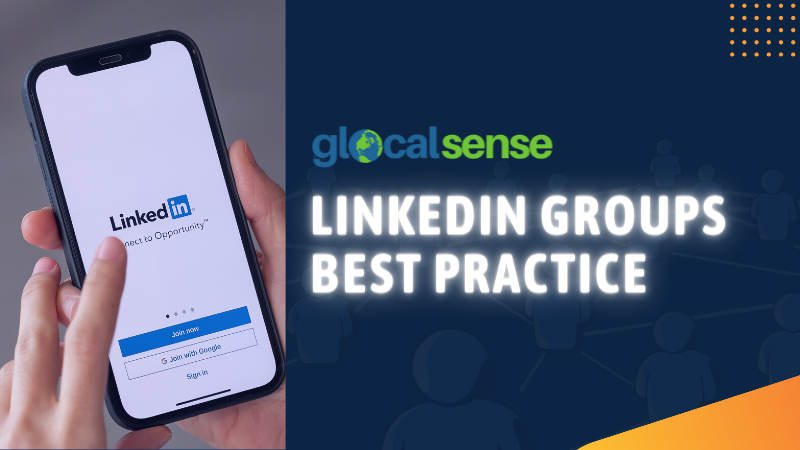The rising use of social media groups to create relationships and locate new opportunities has resulted from the rapid rise of social media to drive business growth. LinkedIn groups are undoubtedly one of the most excellent places for B2B & B2C enterprises as a great social media marketing and engagement strategy.
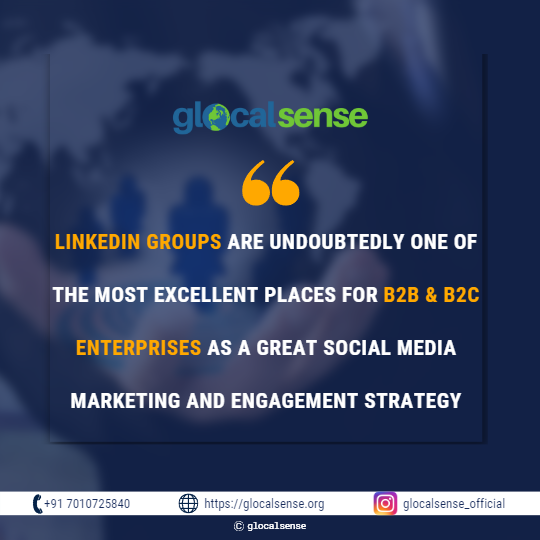
LinkedIn groups are becoming more and more effective at attracting new business. However, if you’re unfamiliar with LinkedIn groups and how they work, this blog can quickly explain you.
It would help if you approached your involvement in LinkedIn groups with a good plan and understanding of best practices to effectively create the most return on investment (ROI).
LinkedIn Groups are “places for professionals in the same industry or with similar interests.” LinkedIn groups can be used to “share content, find answers, post, view job openings, network with industry professionals, and identify as industry experts.”
Benefits of LinkedIn Groups
Being a member of LinkedIn groups relevant to your job responsibilities and career ambitions will benefit your company or individual professional goals.
You may connect with like-minded people and experts in your field to share information, insight, and experiences by joining LinkedIn Groups. In addition, LinkedIn Groups can help your business and professional image in various ways.
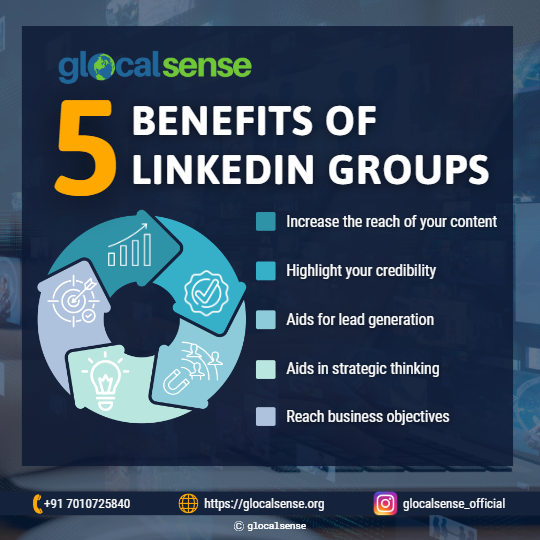
Some of the benefits of joining LinkedIn Groups are as follows:
- Increase the Reach of Your Content
We hope your company has a blog with expert content related to your industry. When you publish it, don’t just share it on your own social media activity feeds; instead, share it directly on LinkedIn Groups. Sharing this post with a group will direct your content to users interested in it because they have also joined the group.
LinkedIn Group members are more likely than personal connections to engage with your niche content. Because they frequently receive LinkedIn Group updates directly to their inboxes and are interested in the specific topic of focus.
2. Highlight Your Credibility
As an organization, you want to constantly demonstrate to Users that you are at the top of your industry. Posting to LinkedIn Groups helps you establish your industry expertise. When your peers in your industry regard you as a leader in your field, your ideal customer is more likely to approach you first. In this way, the benefits of LinkedIn Groups are substantial. LinkedIn Groups are especially useful for freelancers in this regard. They can be a source of new clients to work with.
3. Aids for lead generation
Joining groups that include your target audience will benefit your business as a marketer. You will benefit as a professional from expanding your network, but your manager will also notice your commitment to outreach.
LinkedIn is a highly effective lead generation tool. More people turn to LinkedIn Groups for advice, insight, and cutting-edge industry information. As it is the Web’s leading professional social media networking site, it’s no surprise.
4. Aids in strategic thinking
While you may not always have interesting articles to share, posting intriguing questions relevant to your industry is a good start. LinkedIn Groups is another excellent way to generate buzz for your professional profile or organization.
When you ask the right questions or even provide answers to others’ questions, you establish your credibility and demonstrate that you are engaged and enthusiastic about industry news.
5. Reach Business Objectives
If you’re unsure which LinkedIn Groups to join, then conduct a simple search using your professional or organizational expertise in the LinkedIn search bar. Then, click the “Groups” drop-down menu.
- You will be redirected to a slew of relevant niche networks that you can use to further your business objectives.
- After work hours, you can immerse yourself in relevant industry conversations that can put you ahead of your peers.
- When joining and interacting, you will visualize the demographics, decision-makers, and other organizational roles.
Ways to Become a Part of a LinkedIn Group
Now that you’ve come across five benefits of LinkedIn Groups, you’re probably wondering how to get started.
To begin, use the search field at the top to find Groups that interest you. There are two approaches to this. You can either search for Groups by name or keyword or browse LinkedIn’s Group recommendations.
- Choose Groups from the drop-down menu on the left of the search box at the top of any page.
- Enter your keywords here.
- You can use the filters on the left side of the search results page to narrow down your searches.
If you’d instead look through groups that LinkedIn has recommended particularly for you:
- Hover your cursor over the Interests bar at your homepage and select Groups.
- To see your suggested groups, go to the top of the page and click Discover.
- Click the Ask to Join button to make a membership request (under the group description).
Starting a LinkedIn Group
Hover over the Interests button on your homepage and select Groups from the menu. Then, click the My Groups button on the left side of the page, followed by the Create Group button.
You will be asked to a submission form where you can upload a logo and enter information about your groups, such as their name, summary, description, website, location, and visibility.
It would be beneficial to create a welcoming environment for your new members when you first start. Some good examples of how to accomplish this include:
- Make it simple for people to introduce themselves and share welcoming messages.
- Participate in new members’ posts to encourage them to share their knowledge.
- Share the group’s rules and guidelines to participate in the discussion confidently.
- Send private messages to new members to establish a one-on-one relationship.
It is your responsibility to keep your LinkedIn Group community growing.
The following are some suggestions from LinkedIn’s guide to engaging and growing Groups for building your community:
- Allow members to share your logo on their profiles, as traffic from member profiles accounts for 20% of total group growth.
- Allow only group members to post to maintain some privacy and exclusivity.
- Please make use of your brand’s logo to entice LinkedIn members to join your group (as they are ten times more likely to do so when a logo is visible)
- Encourage members to share information about the group on their other social networks.
- Send out a weekly newsletter highlighting the most important discussions in the group that week.
How to Make Use of LinkedIn Groups
LinkedIn groups can benefit your business, but only if you approach them correctly. Here are the best practices to ensure you get the most value for money from your time spent in these groups.
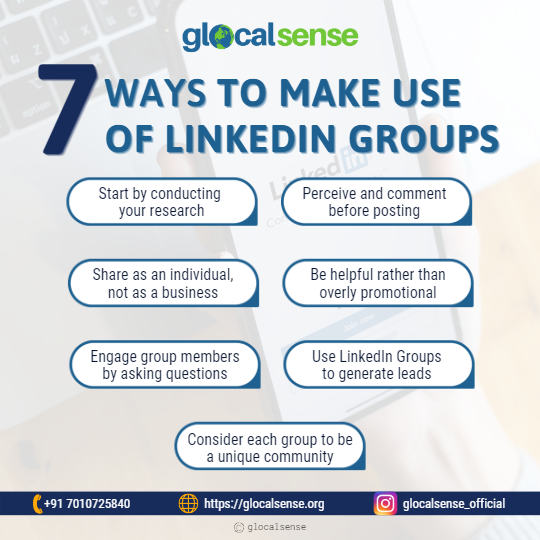
1. Start by conducting your research
You can’t just join a random group and begin pushing your product right away. Instead, you’ll need to do some preliminary research before you start.
Use a LinkedIn group search to find relevant and active groups in your sector. First, make a list of potential target groups and then join them. Once you’re in, you’ll continue your research by carefully observing the activities of each group.
2. Perceive and comment before posting
Before posting your thoughts or content in a social media group, you should get to know the group and how it works.
Take note of which topics the group members are posting about and the type of discussion those posts generate in the form of comments.
Once you’ve figured out who the group is and what it stands for, you can start commenting on posts and responding to others’ comments. It allows you to gradually integrate into the group, which is more effective than joining and immediately posting company promotions.
3. Share as an individual, not as a business
When you’ve finished your research and are ready to start sharing your posts, do so as an individual, not as a company.
Your company’s social media manager should join and participate in groups using their profile. However, it would help if you never tried to join a group using your official company profile.
When you join with your company profile, it is clear that your goal is to sell your product. Furthermore, many group administrators will turn down invitations from company profiles.
4. Be helpful rather than overly promotional
Remember that other members did not join the group to receive sales pitches or product promotions when sharing your posts. Instead, they joined to learn about new trends, connect with other members, and learn about their industry.
Begin by disseminating valuable and essential industry news or trends. Avoid sharing your content at first. Instead, seek out and share useful and relevant content from others.
Start by sharing helpful resources that solve everyday problems for other group members. Then, they will begin to see you as a thought leader.
5. Engage group members by asking questions
Once you’ve established your presence in a specific group, engage members as frequently as possible. Commenting on other people’s posts and posting your own in the form of questions is a great and effective way to accomplish this.
You will encourage other members to share their thoughts by asking pertinent questions. It will initiate a conversation and aid in developing potential relationships with other members.
Furthermore, suppose members see you asking questions to engage the group; they will understand that you are there to participate, learn, and contribute to the learning of other members, not to sell your product or service.
6. Use LinkedIn Groups to generate leads
LinkedIn groups can be a very effective place to generate leads. However, you can also use a LinkedIn integration to streamline your efforts and track your results if you use an all-in-one CRM. All-in-one CRM includes contact management, marketing automation, sales enablement, and service help desk capabilities, all on the same platform.
Members will begin to look for your posts to solve their problems once they have established themselves as a thought leader and have a positive reputation in a group.
When someone comments on your post, replies to one of your comments, or tags you in a post, you can contact them and invite them to join your network. However, avoid attempting to connect with anyone who hasn’t directly engaged.
7. Consider each group to be a unique community
To maximize your group presence exposure, you should join various groups. Of course, the groups you join will be related to or cover similar topics in your industry. As a result, there will be others who are also members of those multiple groups, which means they will see your posts in each group you share them with.
Because of this overlap, never share the same post with more than one group. People who belong to multiple groups will quickly notice, and they will begin to doubt your authenticity. Instead, make an effort to share individual posts with each LinkedIn group you join.
Best Practices of LinkedIn Groups – as a Marketing Tool
LinkedIn, the “world’s largest professional network,” is intended to help increase brand awareness. Here’s how to use its group feature to boost engagement with specific audiences. LinkedIn groups are outstanding for raising brand awareness and engaging your target audience. Here are the 12 best practices for using them as a marketing channel for your company.
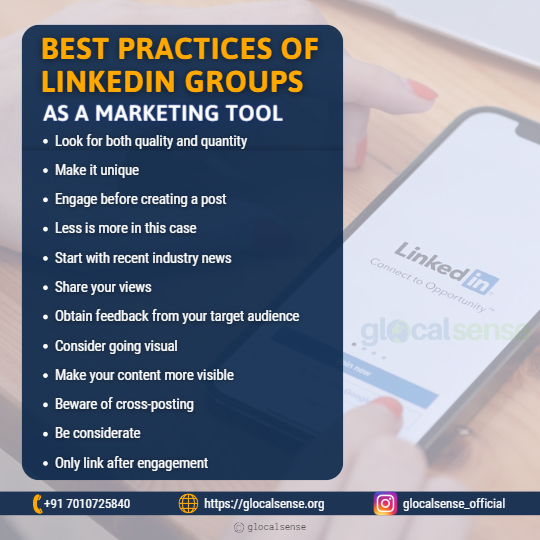
- Look for both quality and quantity
Suppose you want LinkedIn groups to be an effective distribution channel for your content and a source of potential leads. In that case, you must post to the right groups. When developing your list of target groups, consider both group size (for example, audience scale) and posting frequency (for example, audience engagement). A simple search will yield a list of the most influential, most relevant, and most active groups associated with your keyword.
2. Make it unique
Individuals can create a group on LinkedIn. As a result, you publish as a person rather than a company. Have each team member submit a request acceptance post as an individual to all of the target groups.
3. Engage before creating a post
When you join a new group online, just like in real life, before you begin establishing the plan, you must first get a sense of the dynamics of the group. Begin by liking or commenting on other people’s postings in the group. Do this for three to four weeks before sharing your news, content, and views.
4. Less is more in this case
You’ll want to post even after establishing yourself as a valued contributor to the group’s discussion. Posting once a month may be sufficient, depending on the frequency of posts to the particular group. After all, you don’t want the group’s feed to become an echo chamber.
5. Start with recent industry news
What should you post when it’s time to start posting? Compiling and sharing relevant material with each group provides a welcome and straightforward access point across the board.
6. Share your views
Include a quick summary or ask a question when posting a news item. For example, “Do you agree with X in this piece?” or? “I think this prediction is way off because…” are some quality phrasing suggestions for posting with a higher engagement potential.
Simply stating that something is “interesting” or commenting with “Great piece!” is too general and impersonal. As a result, such posts are less likely to generate interaction.
7. Obtain feedback from your target audience
Professionals have created LinkedIn groups who have agreed to talk about a specific topic. They can also function as a ready-made focus group for your brand.
Ask open-ended questions about industry trends, pain points, and challenges, or test your messaging while getting to know your targets better.
8. Consider going visual
Given the feed’s text-based nature, visual content performs well in groups. Focus on:
- Images / Infographics
- Ebooks
- White papers
- Articles
9. Make your content more visible
It’s fine to start sharing your content with the group once you’ve established yourself as a valuable community member. This move typically occurs after six to eight weeks of adhering to the outlined best practices.
You can also invite members to events and webinars and make major company or product announcements. Hopefully, by this point, the group members will be delighted to hear your news, and they will be eager to help spread it through their social networks.
10. Beware of cross-posting
Many of your target groups’ memberships will overlap, regardless of your industry or function. Therefore, avoid posting the same article or question to multiple groups or angles tailored to each audience.
11. Be considerate
Also, please make an effort to respond to comments and questions as they come in.
12. Only Link after engagement
Before linking to someone, wait till they like or comment on your post. Thank the individual for commenting when you finally connect. You may have a new lead based on the comment or reaction.
Final thoughts
Using LinkedIn groups as a marketing medium effectively will:
- You can make genuine connections and have one-on-one conversations with your target audience using the right tools.
- Create a space for qualified prospects to learn about your company’s news and values.
- Create a community around your business, which will allow you to distribute your content to the community members’ social networks.
- Create prospects and leads who have demonstrated a genuine desire to learn more about your products and services.
According to TechCrunch, there are more than two million LinkedIn groups. In addition, more than half of LinkedIn users are members of at least one. With those numbers in mind, it’s simple to see how crucial LinkedIn group membership is for your social media marketing efforts.
You’ll notice substantial benefits from your group involvement efforts if you create a strategy and execute the guidelines above. With the growing popularity of LinkedIn groups, it’s vital to become involved if you haven’t already.
